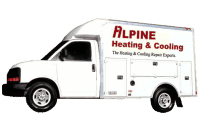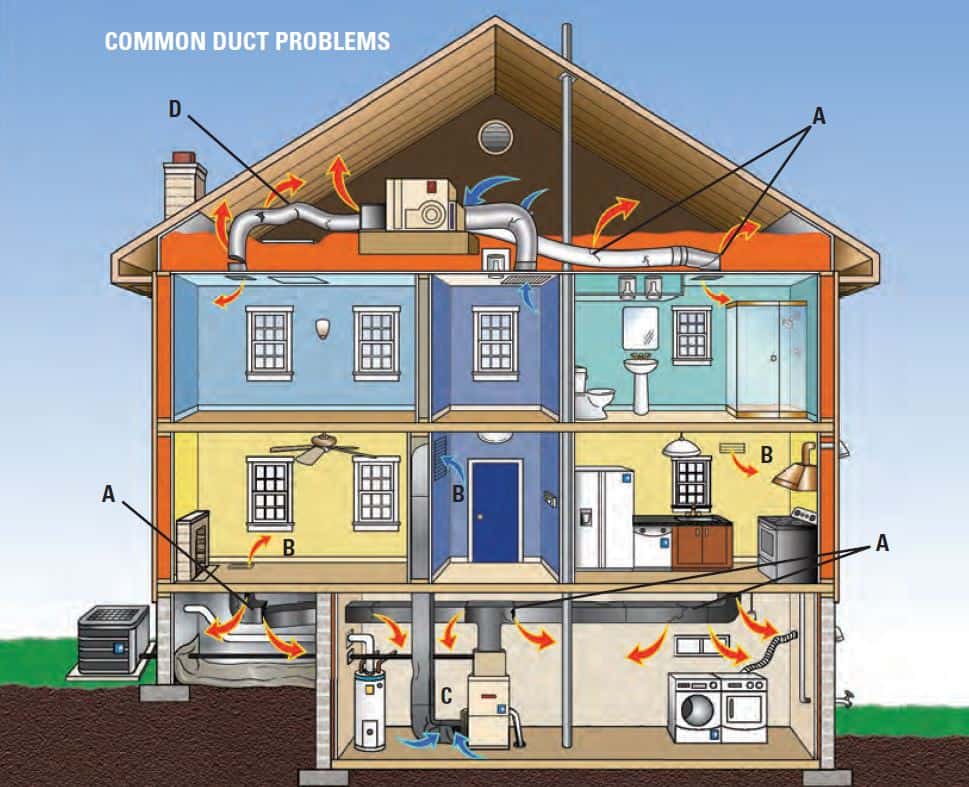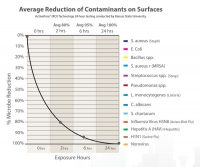
While our attention is focused on the spread of Coronavirus, and we are thinking about the necessary precautions that are needed to reduce our chances of coming in contact with this virus, HVAC professionals know that Coronavirus is not the only disease, germ, virus, or pollutant we need to combat in our homes. We also need to consider the other viruses and germs that are spread through a central HVAC system. People spend about 90% of their lives indoors, and pollutant levels can be as high as 100 times the levels encountered  outside. The Environmental Protection Agency (EPA) ranks indoor air pollution among the top four environmental hazards in America. One-way people can be proactive and protect themselves from getting sick in general is by being educated on Indoor Air Quality (IAQ).
outside. The Environmental Protection Agency (EPA) ranks indoor air pollution among the top four environmental hazards in America. One-way people can be proactive and protect themselves from getting sick in general is by being educated on Indoor Air Quality (IAQ).
There are four particular groups (although all people could benefit) that need the best possible air quality in the home:
- Infants to 16-years-old
- Adults, age 60 plus
- No age restriction – immune-compromised individuals, pregnant women, and persons with chronic respiratory disorders, and those recovering from surgical procedures or illness
- Pet owners with domestic animals – dogs, cats, and birds
Scientist believes the principal transmission mode of the Coronavirus is by respiratory droplets, which may travel several  feet from someone who is coughing or sneezing. Covering your mouth when you cough or sneeze is the first step to control the spread. However, residual contaminants can travel through your HVAC system, where all air in the home is circulated and can contribute to the spread of an airborne virus. The Coronavirus has the same traits as other viruses such as the common cold, the flu, and a sore throat, by how it is spread from person-to-person.
feet from someone who is coughing or sneezing. Covering your mouth when you cough or sneeze is the first step to control the spread. However, residual contaminants can travel through your HVAC system, where all air in the home is circulated and can contribute to the spread of an airborne virus. The Coronavirus has the same traits as other viruses such as the common cold, the flu, and a sore throat, by how it is spread from person-to-person.
Source control is always the first step when dealing with IAQ concerns such as mold, dust, odor, and even viruses. There are many remedies when it comes to managing IAQ in a home. Some products range from a higher Minimum Efficiency Reporting Value (MERV) rated filter, electronic air cleaners, and ultra-violet sterilization systems. The HVAC system and duct system can contribute to spreading unwanted pathogens in the air, not because your system came contaminated from the factory, but because the air in your home became contaminated.
Tiny pathogens spread in the air can be fungi, bacteria, or viruses. The difference between a virus and bacteria is viruses are much smaller than bacteria, and viruses cannot survive without a host. According to the Mayo Clinic, fewer than 1% of bacteria cause disease in people.
In addition to spreading viruses through an HVAC system, another nemesis is mold, a biological growth. Mold is, in the  simplest terms, part of the “dust to dust” program. Everything living will die, it will return to the food chain, whether it’s a mighty oak tree, your favorite leather shoes (once upon a time, a cow), or that forgotten orange in the back of the refrigerator.
simplest terms, part of the “dust to dust” program. Everything living will die, it will return to the food chain, whether it’s a mighty oak tree, your favorite leather shoes (once upon a time, a cow), or that forgotten orange in the back of the refrigerator.
Your HVAC system can provide biological growth the perfect opportunity to form and grow. There are three things needed to support biological growth. Food is the number one source of supporting biological growth. One example of food sources is skin cells that have flaked off and floated into the HVAC system. The next item to support organic growth is moisture. Once those skin cells made it through the system, they can become attached to the evaporator coil or blower motor. When the coil starts to produce condensation along with the food source, it becomes the perfect recipe for biological growth. The final item to contribute to organic growth is the absence of ultraviolet light. HVAC professionals and homeowners who manage these factors, reduce the risk of biological growth.
To set the record straight:
- Mold and viruses are not a factory option
- AC units do not create mold or viruses
- If you have mold or viruses, it is your mold and viruses
- An ultra-violet system will not keep your home mold or virus-free
When an ultra-violet system is used correctly and installed to the manufacture’s guidelines, it can prove to be a useful tool. Ultra-violet exists in natural sunlight (it’s why we wear sunscreen, and mold grows under a rock), it disassembles the DNA of organics. It reduces them to nitrogen and oxygen. Ultra-violet is most effective as surface irradiation (with a limited “kill zone”) and is used in many applications. It is used to sterilize medical instruments, clean reclaimed water in treatment plants, saltwater aquariums, and is used in food processing.
Contractors should educate customers on the value of IAQ and provide solutions and options to help the homeowner make educated decisions. An HVAC system should be inspected at a minimum, twice a year. Visit The National Air Duct Cleaners Association for recommendations on HVAC system cleaning. Be sure to ask your HVAC technician on products that can help you breath cleaner, fresher, healthier air.
In times like these, when emotions run high, and everyone is concerned about the unknown, HVAC professionals need to shine as a beacon of truth and good faith. Quality maintenance, good hygiene, and proven best practices such as; improved indoor air quality, source control for contamination, and keeping a clean house are the keys to successfully navigating current health issues.
By: Matt Akins, ACCA Manager of HVACR Education
ACCA is a non-profit association serving more than 60,000 professionals and 4,000 businesses in the indoor environment and energy services community. Our member firms are the nation’s most professional contracting businesses, serving residential and commercial customers in every state. With roots stretching back a century, ACCA was incorporated in its present form nearly 50 years ago. Today, ACCA sets the standards for quality comfort systems, provides leading-edge education for contractors and their employees, and fights for the interests of professional contractors throughout the nation. Learn more about ACCA here.
Reference Sources
https://www.epa.gov/report-environment/indoor-air-quality
https://www.cdc.gov/mmwr/volumes/69/wr/mm6908e1.htm
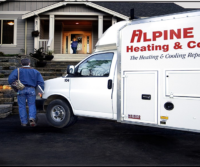
A ductless split system represents a significant investment in comfort, safety, and efficiency. To enjoy the many benefits of ductless technology, it is important to understand the various elements involved in a successful installation. Alpine Heating & Cooling encourages anyone considering an HVAC equipment purchase to explore the cost-effective and environmentally friendly solutions provided by ductless split system advantages.
The Advantages of Ductless Technology
Every year more homeowners in Skagit Valley become acquainted with the versatility of ductless air conditioners and heat pumps. When compared to traditional furnaces and central air conditioning equipment, mini splits offer numerous compelling benefits.
- Versatility: For room additions, garage conversions or areas requiring supplemental heating and cooling, ductless equipment is quiet, efficient and easy to install.
- Reduced Energy Costs: Point-of-use air handlers deliver conditioned air directly into each room without the loss of thermal efficiency associated with an air distribution network. Ductless systems include advanced inverter technology, which offers the highest SEER ratings in the industry.
- Better Comfort: The zoning concept behind ductless design saves energy and also helps improve indoor comfort. The temperature in every room can be tailored to meet the personal requirements of each occupant.
The Importance of Design
In the system design phase, Alpine Heating & Cooling complete calculations to establish the specific load requirements for every room in the building or home. Equipment is selected so that the capacity matches the heaviest theoretical load that could occur during extreme weather.
Many companies that use outdated “rule of thumb” formulas for sizing equipment can compromise comfort, humidity control and degrade system performance.
Why Choose Alpine Heating & Cooling
Regardless of the build quality of the equipment, Alpine Heating & Cooling will have a substantial impact on performance, efficiency, and longevity. Alpine Heating & Cooling has extensive experience and knowledge and provides important services that will help keep HVAC systems running dependably over an extended lifecycle.
Since heating and air conditioning is a highly specialized industry, it is important to choose a company that has a suitable level of knowledge and experience to address the specific requirements of the job.
- Areas of Expertise: Many HVAC companies specialize in a specific industry discipline. This includes new construction, retrofit, commercial HVAC and service. Alpine Heating & Cooling has the skill and expertise to directly meets the requirements for a particular application and will result in a more successful and less expensive outcome.
- The Screening Process: References and referrals are important tools to verify the quality of our work – check out our reviews!
Understanding SEER Ratings
The Seasonal Energy Efficiency Ratio (SEER) is a federal standard designed to provide consumers with an easy way to compare the operating costs for different brands and models of air conditioners. Relative efficiency between two machines can be calculated by dividing the higher SEER rating by the lower SEER rating. For example, replacing a 10 SEER air conditioner installed in the early 2000s with a high-efficiency 16 SEER unit can save up to 60 percent on annual cooling costs, depending on local climate conditions.
Energy Savings Tips
Homeowners can dramatically lower heating and cooling operating costs by changing minor lifestyle habits and considering several relatively inexpensive upgrades.
- Closing the Blinds: Window coverings provide protection against convection and radiant heat. Shades with a k-value rating can reduce the thermal gain from single-pane windows by up to 50 percent.
- Replace Light Bulbs: A conventional light bulb produces 10 percent light and 90 percent heat when it is lit. A compact fluorescent or LED light bulb is far more efficient, especially in climates with extreme summer heat. In fact, over half the total energy savings from a light bulb replacement can be attributed to the reduced summer cooling load.
- Plant Shade Trees: Shade trees have a positive impact on climate change and can help reduce a home’s total air conditioning load when strategically positioned to reduce the effects of south and west sun exposure. The energy savings can be magnified for homes with a significant amount of exterior glass.
- Raise the Thermostat: Raising the thermostat by one degree during summer months can lower energy usage by up to five percent and also reduce equipment-related stress.
- Upgrade Insulation: For older homes with loose perimeters, insulation offers the greatest energy savings per dollar invested. For homes built before the year 2000, upgrading insulation levels to meet current Department of Energy standards can save up to 30 percent on annual cooling costs with an associated payback of less than five years.
Repair or Replace
Even with proper maintenance, a central air conditioner or furnace will eventually need to be replaced. Whether due to age or obsolescence, equipment begins to malfunction and repair costs mount. As performance diminishes, utility costs continually rise as the HVAC unit must work harder and longer to satisfy the indoor load.
While there is no specific timeline for equipment longevity, HVAC systems that are eight years or older should be considered for replacement. Leading-edge ductless systems combine exceptional levels of comfort with the highest available efficiencies.
Alpine Heating & Cooling invites you to learn more about the versatility, efficiency and attractive appearance offered by modern ductless split systems.
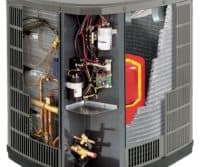
If your HVAC system is old (10 – 15 years) or not working, consider replacing your HVAC equipment with a high-efficiency unit that has earned the ENERGY STAR. It’s a good idea to do some research on options for a new heating or cooling system before your current one breaks, so you can make an informed decision if you need to act quickly.
How much energy you save will vary based on your use and climate, with colder regions saving more with ENERGY STAR heating equipment and hotter regions saving more with ENERGY STAR cooling equipment. Let’s take a look at different types of HVAC equipment to help you with your decision.
Furnaces
Furnaces are the most commonly used residential heating system in the United States. Running most often on gas, but sometimes on oil, propane, or electricity, furnaces deliver their heat through a duct system. Furnaces that have earned the ENERGY STAR have higher AFUE (Annual Fuel Utilization Efficiency) ratings. AFUE is the measure of heating equipment efficiency, represented as a percentage. Most furnaces that can qualify for the ENERGY STAR will be “condensing” furnaces where the transfer of heat is so thorough water or condensate is a byproduct of combustion. This condensing occurs with systems over 90 percent efficient. Another feature of efficient furnaces is a highly efficient blower motor (commonly an ECM, Electronically Commutated Motor, or another type of “advanced main air circulating fan”).
Boilers
A boiler heats your home by burning gas, propane, or oil to heat water or steam that circulates through radiators, baseboards, or radiant floor systems. Boilers do not use a duct system. Boilers that have earned the ENERGY STAR have higher AFUE ratings. Features that improve boiler efficiency include electronic ignition, which eliminates the need to have the pilot light burning all the time, and technologies that extract more heat from the same amount of fuel.
Central Air Conditioners
Most residential central air conditioners are called “split-systems” because they have an outdoor component with a condenser and compressor and an indoor component with an evaporator coil. It’s very important to replace both of these units at the same time. Installing a new outdoor unit without replacing the indoor unit is likely to result in low efficiency, and may lead to premature failure of the system.
ENERGY STAR qualified central air conditioners have higher SEER (Seasonal Energy Efficiency Ratio) and EER (Energy Efficiency Ratio) ratings than today’s standard models. SEER is the most commonly used measurement of efficiency for air conditioners. It measures how efficiently a cooling system will operate over an entire season. EER measures how efficiently a cooling system will operate when the outdoor temperature is at a specific level (95 degrees F).
The central air conditioner also needs a blower motor—which is usually part of the furnace—to blow the cool air through the duct system. The only way to ensure that your new air conditioner performs at its rated efficiency, is to replace your heating system at the same time. It’s especially recommended if your furnace is over 15 years old. If you purchase a new energy-efficient air conditioner but connect it to an older furnace and blower motor, your system will not perform to its rated efficiency.
Heat Pumps
Heat pumps provide both heating and cooling in one integrated system.
Electric Air-Source Heat Pumps (ASHPs). ASHPs, often used in moderate climates, use the difference between outdoor and indoor air temperatures to cool and heat. ENERGY STAR qualified ASHPs have higher SEER and EER ratings than conventional models. They also have a higher Heating and Seasonal Performance Factor (HSPF), which measures the heating efficiency of the heat pump.
Geothermal Heat Pumps (GHPs). GHPs are similar to air source heat pumps, but use the ground instead of outside air to provide heating, cooling, and often water heating. Because they use the earth’s natural heat, they are among the most efficient and comfortable heating and cooling technologies currently available. Although initially expensive, you can achieve significant cost savings on energy bills. GHPs are most often installed in new homes and require a duct system.
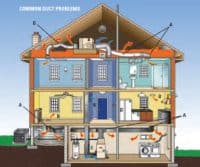
Ducts are used to distribute conditioned air throughout houses with forced-air heating and cooling systems. In
typical Skagit Valley houses, about 20 percent of the air that moves through the duct system is getting lost due to leaks, holes, and poorly connected ducts. The result is an inefficient HVAC system, high utility bills, and difficulty keeping the house comfortable, no matter how you set the thermostat.
Simple Steps to Improving Duct Performance
Because ducts are often concealed in walls, ceilings, attics, and basements, repairing them can be difficult. But there are things that you can do to improve duct performance in your house.
Start by sealing leaks using mastic sealant or metal (foil) tape and insulating all the ducts that you can access such as those in the attic, crawlspace, basement, or garage. Never use ‘duct tape,’ as it is not long-lasting.
Also make sure that the connections at vents and registers are well-sealed where they meet the floors, walls, and ceiling. These are common locations to find leaks and disconnected ductwork.
A: Leaky, torn, and disconnected ducts
B: Poorly sealed registers and grills
C: Leaks at furnace and filter slot
D: Kinks in flexible ductwork restricting airflow
Contact Alpine Heating and Cooling for more information on duct improvement projects.
- inspect the entire duct system,
- evaluate the system’s supply and return air balance,
- repair or replace damaged, disconnected, or undersized ducts and straighten out flexible ducts that are tangled or crushed,
- seal leaks and connections with mastic, metal tape, or an aerosol-based sealant.
- seal gaps behind registers and grills where the duct meets the floor, wall, or ceiling
- insulate ducts in unconditioned areas with insulation that carries an R-value of 6 or higher
- include a new filter as part of any duct system improvement
- Use diagnostic tools to evaluate air flow after repairs are completed
- Ensure there is no back drafting of gas or oil-burning appliances, and conduct a combustion safety test after ducts are sealed.
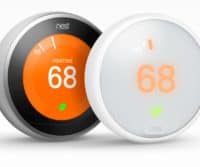
A programmable thermostat is ideal for people who are away from home during set periods throughout the week. Through proper use of pre-programmed settings, a programmable thermostat can save you about $180 every year in energy costs in Skagit Valley.
How Do You Choose the Right Programmable Thermostat or You?
To decide which model is best for you, think about your schedule and how often you are away from home for regular periods—work, school, other
activities—and then decide which of the three different models best fits your schedule:
- 7-day models are best if your daily schedule tends to change; for example, if
children are at home earlier on some days. These models give you the most
flexibility and let you set different programs for different days—usually with four
possible temperature periods per day. - 5+2-day models use the same schedule every weekday, and another
for weekends. - 5-1-1 models are best if you tend to keep one schedule Monday through Friday
and another schedule on Saturdays and Sundays.
Programmable Thermostat Settings
You can use the table below as a starting point for setting energy-saving temperatures and then adjust the settings to fit your family’s schedule and stay comfortable.

Get the Greatest Benefit from Your Programmable Thermostat
- Install your thermostat away from heating or cooling registers, appliances,
lighting, doorways, fireplaces, skylights and windows, and areas that receive
direct sunlight or drafts. Interior walls are best. - Keep the thermostat set at energy-saving temperatures for long periods of time,
such as during the day when no one is home and at bedtime. - Set the “hold” button at a constant energy-saving temperature when going
away for the weekend or on vacation. - Resist the urge to override the pre-programmed settings. Every time you do, you
use more energy and may end up paying more on your energy bill. - Use a programmable thermostat for each zone of your house if you have
multiple heating and cooling zones. This will help you maximize comfort,
convenience, and energy savings throughout the house. - Change your batteries each year if your programmable thermostat runs on
batteries. Some units will indicate when batteries must be changed.
If you have a heat pump, you may require a special programmable thermostat to maximize your energy savings year-round. Talk to your retailer or contractor for details before selecting your thermostat.
If you have a manual thermostat, you can adjust the temperatures daily before you leave the house and when you go to sleep at night. Typically, adjusting temperatures 5 – 8 degrees (down in winter, up in summer) can help save energy if you are going to be away from home for several hours.

Dirt and neglect are the top causes of heating and cooling system inefficiency and failure in Skagit Valley. To ensure an efficient system
operation, it’s essential to maintain your HVAC system.
Change your air filter regularly. A clean filter will prevent dust and dirt from building up in the system, which can lead to expensive maintenance and early system failure. Check your filter every month, especially during winter and summer months, when use tends to be heavier. Change your filter if it’s dirty—or at least every three months to maintain your HVAC system properly.
Tune up your HVAC equipment. Proper maintenance by an Alpine Heating and Cooling qualified technician is one of the most important steps you can take to prevent future problems. We get busy during the summer and winter months, so it is best to check the cooling system in spring and the heating system in the fall. Plan the checkups around the beginning and end of daylight-saving time each spring and fall.
Overall HVAC System Maintenance Checklist
- Check thermostat settings to ensure the heating and cooling system turns
on and off at the programmed temperatures. - Tighten all electrical connections and measure voltage and current on
motors. Faulty electrical connections can cause your system to operate
unsafely and reduce the life of major components. - Lubricate moving parts. Parts that lack lubrication cause friction in motors
and increase the amount of electricity you use. Lack of lubrication can also
cause equipment to wear out more quickly, requiring more frequent repairs
or replacements. - Check and inspect the condensate drain in your central air conditioner,
furnace, and heat pump (when in cooling mode). If plugged, the drain
can cause water damage in the house, affect indoor humidity levels, and
breed bacteria and mold. - Check system controls to ensure proper and safe operation. Check the starting
cycle of the equipment to assure the system starts, operates, and shuts
off properly. - Inspect, clean, or change the air filter in your central air conditioner, furnace,
and heat pump. Your contractor can show you how to do this yourself.
Depending on your system, your filter may be located in the duct system versus
the heating and cooling equipment itself.
Additional HVAC System-Specific Maintenance Activities
For Heating Systems:
- Inspect the flue piping for rusting and any disconnections or evidence of
back drafting. - Check all gas (or oil) connections, gas pressure, burner combustion, and heat
exchanger. Improper burner operation can be caused by a dirty burner or a
cracked heat exchanger—either can cause the equipment to operate less safely
and efficiently. Leaking gas (or oil) connections are also a fire hazard and can
contribute to health problems.
For Cooling Systems:
- Clean indoor and outdoor coils before warm weather starts. A dirty coil
reduces the system’s ability to cool your home and causes the system to run
longer, increasing your energy costs and shortening the life of your equipment. - Check your central air conditioner’s refrigerant charge and adjust it if
necessary to make sure it meets manufacturer specifications. Too much or too
little refrigerant charge can damage the compressor, reducing the life of your
equipment and increasing costs. - Clean and adjust blower components to provide proper system airflow. Proper
airflow over the indoor coil is necessary for efficient equipment operation
and reliability.
Alpine Heating & Cooling services all of Skagit Valley including Anacortes, La Conner, Mount Vernon, Sedro-Woolley, and Burlington. Contact us today to schedule maintenance for your HVAC system!
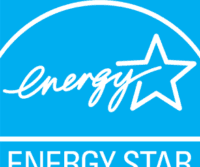
Consider Making a Change to Your HVAC System if Any of the Following Statements Apply
Some of your rooms are too hot or cold. Inadequate air sealing or insufficient insulation could be the cause. No matter how efficient your heating and cooling system is, if your home is not adequately sealed and insulated, you will not be as comfortable, and your system will have to work harder. Your home has humidity problems, excessive dust, or rooms that never seem to get comfortable. Leaky or poorly insulated ductwork might be the cause and reason to change your HVAC system.
Your equipment needs frequent repairs, and your energy bills are going up. In addition to the rise in energy costs, the age and condition of your heating and cooling equipment may have caused it to become less efficient. Call Alpine Heating & Cooling to take a look at your current system. Alpine can offer you solutions that work for your budget.
Your heating and cooling equipment is more than ten years old. Consider replacing it with newer, more efficient equipment. And remember, high-efficiency levels begin with ENERGY STAR.
You leave your thermostat set at one constant temperature. You could be missing a great energy-saving opportunity. You can set a programmable thermostat to adjust your home’s temperature at times when you’re regularly away or sleeping.
You used EPA’s ENERGY STAR Home Energy Yardstick to compare your household’s energy use to others across the country, and your score is below five. That means you’re using and paying for more energy at home than most Americans. Visit the ENERGY STAR Home Advisor to get recommendations for home improvement projects that will increase your score by improving your home’s energy efficiency and comfort.

Nothing is more frustrating than when your HVAC system stops working when you need it most, causing you to consider an emergency air conditioning and furnace repair or replacement. Not only is it stressful for you and your family to be without air conditioning or heat, but it can also be a financial strain. There are a few things you can do, however, before calling Alpine Heating & Cooling.
Emergency Air Conditioning and Furnace Repair Checklist
1: Check your furnace’s air filter – if you have not replaced or cleaned it in a while, you may want to purchase a new one, since a dirty filter can restrict airflow through your home.
2: Check your circuit breakers – the breaker switch may have tripped or shut off by accident. It is important to keep in mind that a tripped HVAC breaker may indicate a more serious issue, so schedule an inspection with us immediately.
3: Make sure the vents in your home are not obstructed – Blocked or closed vents can limit the airflow through your home.
4: Check the thermostat – if your thermostat uses a battery, it could need to be changed. You can also check to see if there is dust or dirt in the thermostat by removing the faceplate. If there is dust or dirt, use a can of compressed air to gently remove it. Also, frequently changing the temperature on the thermostat can cause the compressor in your system to overheat and shut down. To avoid this, be patient once you set your desired temperature. The system could take up to five minutes for the HVAC system to turn on.
If after going through this emergency HVAC repair checklist and your unit is still not functioning properly, it may be time to call us. A malfunctioning HVAC system could drive up your energy costs along with the expensive emergency furnace and air conditioning repairs. Time is of an essence. Alpine Heating & Cooling will travel to your home in our Skagit Valley service area to assess the HVAC system and create an estimate for the repair and complete the repair.
